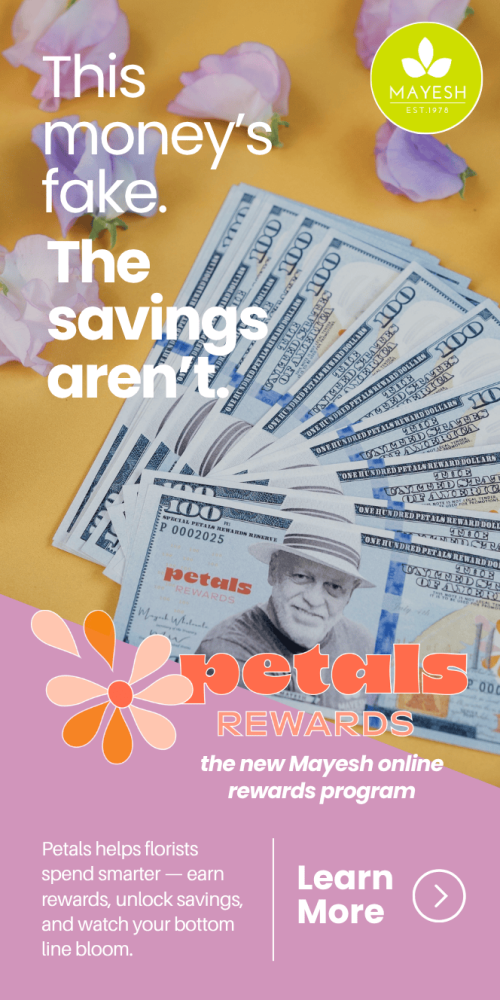“Show your customers how to say more than just “I love you” with their Valentine’s Day bouquets – and year-round, too.”
It’s that time of year – Valentine’s Day, the floral industry equivalent to the Super Bowl. It’s estimated that more than 250 million roses are produced in the name of showing one’s love and affection. And while more than half of American spouses and significant others make a beeline to red or another hue of rose, others opt for mixed bouquets to say, “I love you.” But what if you could say so much more? Such as, “You’re very attractive” (Ranunculus), “You’re silly” (Celosia or coxcomb) or even “You’re a true friend” (Alstroemeria).
Although several floral language dictionaries exist, few bouquets these days are designed with the intention of sending a specific message. But imagine the possibilities for a moment – especially on such a meaningful holiday like Valentine’s Day. Why couldn’t your retail store offer buckets of specific blooms labeled with their meanings? Or include custom tags with your arrangements that give the meaning behind the flowers included? It’s definitely an effort you and your staff would have to coordinate, but there are no words for the impact it could have on your Valentine’s Day customers.
On the following pages are some floral recipes for your spouse or significant other, mother, child, friend or co-worker – and even yourself – that speak volumes.
Even in today’s lavish wedding ceremonies, very few bouquets are designed with a floral message in mind. A notable exception is Kate Middleton, now Catherine, Duchess of Cambridge and presumably England’s future queen. When she married Prince William in 2011, she deliberately gave a nod to floriography, selecting flowers less for their look than for their meanings: myrtle and ivy for love and marriage; hyacinth for sport (the couple bonded over a shared love of athletics); and sweet William for gallantry (a reference to her own sweet William).
Here are recipes for bouquets and arrangements with special messages for various types of recipients for Valentine’s Day. Be sure to create decorative tags to attach to each bouquet or arrangement so the recipients can decipher the meanings of the flowers and discover the special intended messages.
Research more floriography (see “Sources” below), and create designs with special messages for all types of occasions, events and holidays throughout the year. Make these meaningful arrangements a regular part of your floral menu. Also, label buckets of individual blooms with their meanings so customers can create their own bouquets with specific messages. These creative ideas are sure to appeal to many of your customers – especially men, perhaps – and they’ll give you an innovative competitive advantage over other flower retailers. Finally, be sure to promote your distinctive “message bouquets and arrangements” regularly on social media, and watch a following develop.
The language of flowers, or floriography, is considered to be the Victorian era’s equivalent of today’s emoji. Although many credit the Turks for developing flower meanings in the 17th century, it was during the reign of England’s Queen Victoria that flowers were most commonly used to communicate feelings that the strict etiquette of the era would not allow. Sent in the form of small nosegays or tussiemussies, they typically consisted of fragrant herbs and a single meaningful flower wrapped in a lace doily. Would-be suitors presented the bouquets to their prospective lovers to see if they were accepted. Flowers held in the right hand indicated a “yes,” and flowers in the left hand were considered a “no.”
The language of flowers isn’t all about undying love and friendship. Below are some flower types you might want to steer customers clear of on Valentine’s Day – unless they are looking to send a very different kind of message.
Yellow carnation (rejection and distain)
Cyclamen (separation)
Orange lily (hatred and distain)
Petunia (resentment and anger)
Amaranthus (hopelessness)
Variegated carnation (just no)
King Protea (criticism)
Yellow hyacinth (jealousy)
Online
• gardenerdy.com
• theflowerexpert.com
• fiftyflowers.com
• aboutflowers.com
• atlasobscura.com
• interflora.co.uk
Books
• The Language of Flowers by Kate Greenaway
• Flowerpaedia: 1,000 flowers and their meanings by Cheralyn Darcey
• The Posy Book by Teresa H. Sabankaya
Phillip M. Perry is an award-winning business journalist with more than 20 years of experience under his belt. A three-time recipient of the American Bar Association’s “Edge Award” for editorial achievement, Perry freelances out of his New York City office. His byline has appeared more than 3,000 times in the nation’s business press. He maintains a web site at editorialcalendar.net.
























